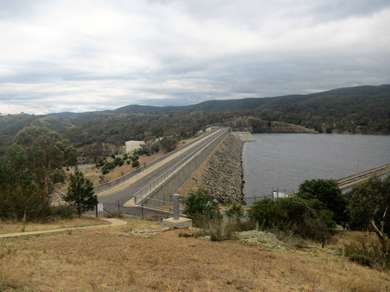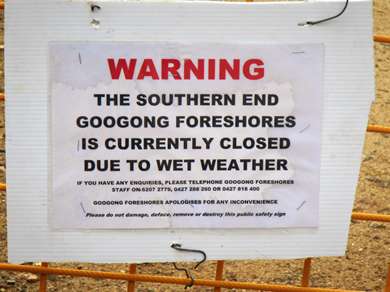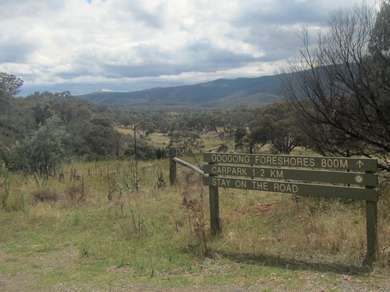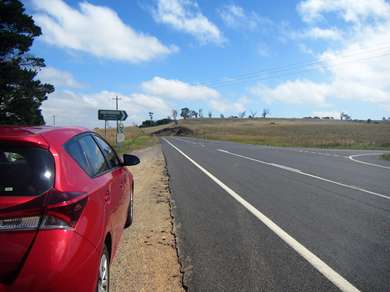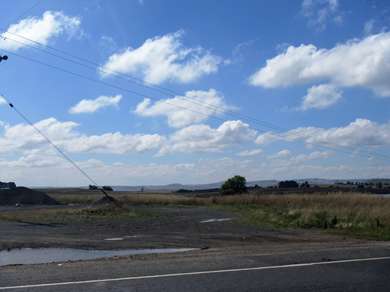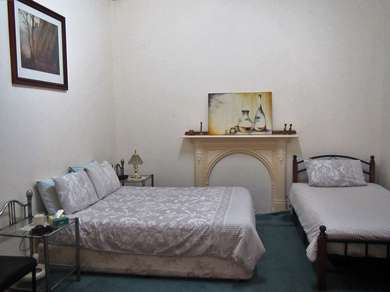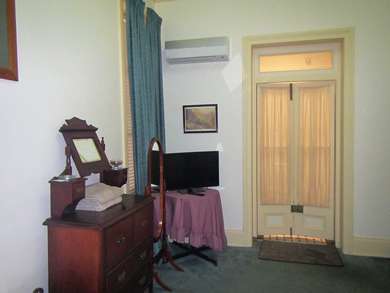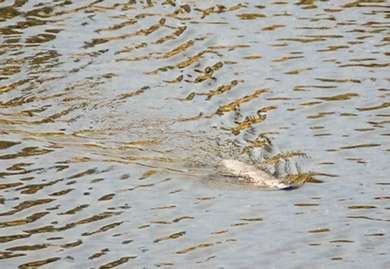Bombala

|
Saturday 23rd January 2016 After two days of wandering museums, we needed some fresh
air and open spaces, and a little research into the local Queanbeyan area
revealed a local landmark called London Bridge a short drive away and
reached by a walking track. Perfect. So after checking out we
headed for the Googong foreshore, about 20 kms south. We stopped first at the Googong Dam, built on the Queanbeyan
River in the 1970’s and opened by HRH Prince Charles in 1979.
Googong Dam, an earthfill and embankment
construction.
Our little red chariot. When we reached the road to the car park, however, we were
very disappointed to find a locked gate bearing a sign telling us that the
foreshore was closed due to wet weather. It had indeed rained very hard
yesterday, but not, we thought, long enough to cause problems.
What?! Surely not! We parked the car beside the road and climbed the fence to
take a look a bit further down the road. A little way along we came to a
sign telling us that the car park where the track began was still over a
kilometre away, and with the sky beginning to promise more rain we reluctantly
decided to give up.
A broody sky and wet conditions – no thanks. Back at the car we retraced our route back to the main road
and set off towards the Snowy Mountains. We were taking the inland route
south, along the Monaro Highway, to join the Princes Highway going west just
before the coast at Cann River. As we passed through Cooma, we decided to
stop at the Snowy Hydro Discovery Centre. This turned out to be a very interesting stop where we
learned a great deal about this huge hydro-electric scheme that uses meltwater
to generate 4,500 gigawatt hours per day of clean energy. It prevents around
4,500,000 tonnes of carbon dioxide being released each year – the
equivalent of the exhaust from around a million cars. The water is then
released into the Murray and Murrumbidgee Rivers for irrigation. The
scheme, which involves 16 major dams, 7 major power stations and 145 km of
tunnels took 25 years to build, by more than 100,000 people from over 30
countries, and was completed in 1974. To meet the needs of all these
workers, 7 towns and 1600 km of roads and tracks were built. 60,000 of
those people stayed in Australia, becoming citizens and making new lives there.
Fascinating. By now time was marching on – just as well the nice
lady at the Snowy Hydro centre had thrown us out as it was early closing day
– so we grabbed a quick burger at Macca’s and were on our way south
again.
A quick stop to change drivers on an empty
road.
The lowlands stretched for miles – a long way to the mountains. We arrived in Bombala late afternoon and discovered why it
had not been easy to find a place to stay – it is a small cluster of
buildings alongside a river, a very sleepy, half-alive little town. We
found the Heritage House B&B, a rather grand building built in 1872 to
house the Commercial Banking Company of Sydney. No-one was home. A
very nice chap who was painting the outside told us the owner had gone to
collect his wife from the airport, and they were due back in an hour or
so. So we went for a wander around the town, which didn’t take
long, and then stopped into the RSL club as it was by this time beer
o’clock. By the time we arrived back at the B&B the owners had
returned and were apologetic about the wait. They showed us to our room
which was clearly an addition to the main building. The only window
looked out into a conservatory, where breakfast was served. Just as well
we weren’t planning to lie in. The French doors to the bathroom were
obviously exterior doors. But it was clean and the bed was comfortable,
and we had use of their kitchen for tea/coffee making, so all was good, if a
little pricey at $130 for one night.
An older style room with mock fireplace and high ceiling. The
bathroom was through these French doors. Once we were checked in, we headed off out again to the
nearby Platypus reserve. Bombala describes itself as being in the heart
of platypus country, with the Bombala riverbanks home to many, and this was our
reason for stopping here. At the reserve we saw our first platypus, the
telltale ripples in the water giving it away long before we saw the animal
itself.
A Cunningham skink warming itself on the rocks by the
riverside.
A platypus on the surface between dives for food. We stayed a while, but saw no more as it was still a while
till dusk, so headed back to the B&B. A quick chat with the owner
revealed that we had just as much chance of seeing a platypus in the river at
the end of the road, and as dusk was now approaching we wandered down there to
have a look. No luck, but it was a very pretty and peaceful place to
wait. Deciding to get up early and walk back down to the river in the
morning, we went back to the restaurant at the B&B and enjoyed a Chinese meal
before hitting the hay. |
